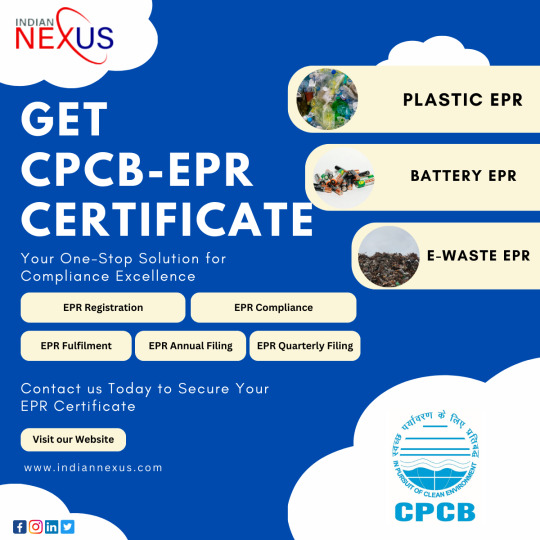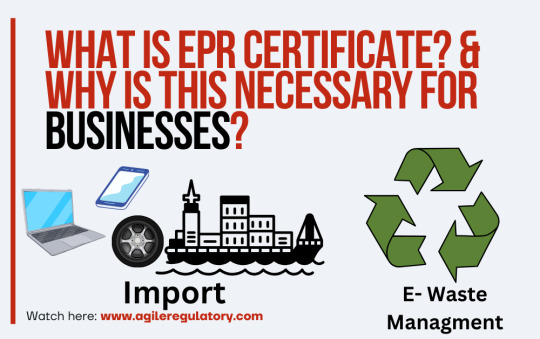#EPR
Text
Impact of E-Waste on Human Health and the Environment
Have you ever wondered what happens to your old electronics when you don't need them anymore? It's important to know about electronic waste or e-waste and how it affects us and the planet.

What is E-Waste?
E-waste is what we call old electronic stuff like phones, computers, and gadgets that people throw away. For detailed guides on E-Waste visit our blog What is E-Waste Recycling? and Why It’s Important
Why Is E-Waste a Problem?
E-waste is a big problem all over the world. Every year, there is more and more of it. This is not good for our health and the environment.
Health Problems
E-waste has dangerous things inside, like lead and mercury. When these things get into our food and water, they can make us sick. Breathing in bad air from burning e-waste is also harmful.
Harm to the Environment
When we don't recycle e-waste, it piles up in big garbage places. This takes up a lot of space and can hurt the land and animals. Also, our electronics have special metals inside that we can use again, like gold and silver. If we don't recycle them, we waste these important things.
What Can We Do?
There are things we can do to help with e-waste:
Use E-Waste Recyclers: E-waste recyclers are people or companies who take our old electronics and make them into new things.
Learn About E-Waste Recycling: There are different ways to recycle e-waste, and it's good to know about them.
Recycling Types: E-waste can be recycled in different ways. Some parts can be used again, and some can be turned into new things.
Let's all do our part to take care of our old electronics and keep our planet clean and healthy.
For a more in-depth exploration of this critical issue, visit our blog Impact of E-Waste on Human Health and the Environment or explore our website, E-Waste Mart.
#tech waste#e waste recycling#electronic waste#epr#e waste#e waste management#ewaste#epr services#recycling#effect of e waste#effect of electronic waste#waste management
2 notes
·
View notes
Text

6 more days until new 「Darker than BLACK」merch is released on the Studio BONES store!
"May you always protect your smile."

14 notes
·
View notes
Text

How to easily get EPR certification online: Learn about the simple registration process and what documents you require to obtain an EPR certificate. Please connect with an Agile Regulatory consultant for expert guidance in every single step.
0 notes
Text

Looking to ensure your CPCB EPR Certificate is hassle-free? Look no further!
Indian Nexus offers a seamless solution for achieving compliance excellence. Our services cover EPR Registration, Compliance, Fulfillment, Annual Filing, and Quarterly Filing, providing comprehensive assistance to streamline your environmental responsibilities. Say goodbye to bureaucratic hurdles and embrace effortless compliance.
Apply now to effortlessly meet your environmental obligations.
📞 Contact Us: +91-9999 803600
📧 Email: [email protected]
🌐 Website: www.indiannexus.com
#BEERegistration#BISRegistration#TECCertification#TECApproval#WPCCertification#ISICertification#CE#CECERTIFICATION#CopyrightProtection#IntellectualProperty#CreativeGenius#BEEStarRating#EnergyEfficientLiving#SustainableHome#ProductCertification#indiannexus#environment#sustainability#compliance#registration#filing#CPCB#EPR
0 notes
Text
Découvrez le dernier ajout passionnant d'Alpha and Omega Semiconductor à l'électronique de puissance : le MOSFET AONZ66412 XSPairFET™, conçu pour les applications USB PD 3.1 EPR. Avec sa conception intelligente et sa haute efficacité, cette nouveauté promet d'optimiser vos systèmes pour une performance énergétique maximale.
0 notes
Text
What are the Key documents required for "EPR Certificate Registration"?
To acquire an Extended Producer Responsibility (EPR) certification in India, the following documents are required:
Business address verification
Manufacturer's or exporter's legal documentation
Certificate of incorporation
Verification of Importer Exporter Code (IE Code)
Approval from the Directorate of Industries
Certification from Municipal Corporations or Local Authorities
Contact and product particulars
PAN Card copy
Authorized personnel's details and documentation
Optional: Bureau of Indian Standards (BIS) license copy
Compliance details regarding Restriction of Hazardous Substances (RoHS)
Information on recyclers
Estimate for e-waste management
Budget Allocation for Extended Producer Responsibility
Details of awareness campaigns
EPR strategy outline
Copies of agreements
#EPR#ExtendedProducerResponsibility#WasteManagement#Sustainability#Recycling#CircularEconomy#EnvironmentalResponsibility#ProductStewardship#ReduceReuseRecycle#WasteReduction#EcoFriendly#GreenInitiative
0 notes
Text
How VAT Ai Simplifies Your EPR Compliance?
EPR (Extended Producer Responsibility) is an environmental policy that makes producers responsible for the entire lifecycle of their products and packaging, including their disposal and recycling.

As sustainability becomes a pressing priority, major online marketplaces like Amazon are now making it mandatory for sellers to follow EPR regulations. Failure to follow EPR rules can lead to account suspensions or permanent bans on these platforms.
How VAT Ai Simplifies Your EPR Compliance?
Understand your product’s specific obligations
Streamline EPR registrations & reporting
Optimize costs through tailored compliance plans
Stay updated on evolving EPR laws across regions
Benefit from dedicated advisory & support
Is your business EPR-ready? Get assistance to ensure compliance and avoid costly penalties. Let’s discuss a tailored solution!
For more info, visit www.vatai.com/products/epr-services
Follow VAT Ai on Social Media:
Facebook: https://www.facebook.com/VATAiofficial/
LinkedIn: https://www.linkedin.com/company/vatai/
Twitter: https://twitter.com/VATAi_Official
YouTube: https://www.youtube.com/@VATAi_Official
0 notes
Text

BRP INFOTECH and Havells India Limited worked together to create an informative awareness campaign that promoted a critical comprehension of EPR and e-waste management.
0 notes
Text
Electron spin resonance (ESR) also known as electron paramagnetic resonance (EPR) is a type of magnetic resonance that is useful for the study of free radicals, paramagnetic species (see section 13.1, p. 544) and other substances containing unpaired electrons.
"Chemistry" 2e - Blackman, A., Bottle, S., Schmid, S., Mocerino, M., Wille, U.
#book quote#chemistry#nonfiction#textbook#electron spin resonance#electron paramagnetic resonance#esr#epr#resonance#free radicals#paramagnetic#magnetic#electrons
0 notes
Text
Learning Management Software: Definition and Features

Learning Management Software, otherwise known as a Learning Management System is a tool that allows you to streamline your work in various organisations. With various LMS tools in the market, each tool has a unique feature that helps the user to collect the information and analyze it thoroughly.
However, finding the right tool that offers Learning Management Software is a big task. We will be looking at the top features of LMS tools.
In this case, we are taking the example of a school using a Learning Management System tool and what features has the school received after using this tool that helps the schools, their teachers, staff, and other students, along with parents, to communicate seamlessly.
Learning Management System
A Learning Management System (LMS) is software to evaluate a particular learning process when it comes to implementing it in a school or educational institution. E-learning practices are facilitated by an online platform, which typically includes two components: a server that performs basic functionality and a UI that is managed by instructors, students, and administrators.
An LMS commonly offers an instructor the ability to create and deliver content, monitor student engagement, and evaluate student achievement. Various interactive features like online discussions, video conferencing, discussion forums, and so much more help students to learn and exchange information.
One of the main features that come with the LMS tool is gathering information, managing documents, analyzing data, and assessing the educational resources, staff, and teachers monitoring. The function changes based on the training strategy and targets that help the schools work efficiently in the long run.
However, even with the advent of advanced technology, various schools have not yet implemented the learning management software system. What most people do not know is that the tool offers both virtual classes and streamlines offline work. The software allows seamless connectivity, tracks progress, and keeps data records so that schools can streamline their work and reduce workloads. Therefore, this software is a blessing in disguise for all.
Features of a Learning Management System
Customized Task Assessment
Imagine a child is not well, and the student has to submit an assignment. There are times when health is a serious issue, yet the teachers have to get their assigned tasks done on time. How easy would it be to manage if the student could upload the task online?
The LMS tool facilitates such benefits by uploading the task online. Similarly, the tool also helps the teacher give the exams online. The teachers can later check the assignment and assign the marks accordingly. The administrators can use the best learning management systems to assign pre-made assessments or create assessments to select the staff and the students.
Blended Learning
The LMS tools offer a blended learning method that is a combination of both traditional and in-person learning in various interactive forms. The tool offers flexibility to attend classes and engage interactively from anytime, anywhere. It is cost-efficient because students and teachers can now interact anytime, anywhere, without having to meet one another face-to-face.
With an LMS, you can include interactive media, quizzes, competitions, and other engaging content in your training sessions. Learning is more likely to be engaged when the focus is on the student rather than being simply absorbed in a static or traditional mode of learning, like interactive sessions, blackboards, and so on.
Dashboards with Reports and Analytics
We know that every student has a different style of performing. Some might be good at studying, while others might be good at curricular studies. No two students can perform the same.
Therefore, an LMS allows administrators and teachers to customize student data so they can monitor the performance of the students, including participation, completion, and overall progress. It is important to have a customizable dashboard that includes detailed visualizations and charts for reporting, while other features like individual progress tracking and check-in data are also helpful.
Social Learning
In the contemporary world, it is better to integrate some innovative ideas to help students learn their courses. Social learning plays a crucial role in this aspect because children get an interactive platform to perform and stay updated with the latest scenarios.
Features in LMS enable the students to learn among themselves using various social learning methodologies, like chatting, video conferencing, and so on are no more than a surprise. Apart from making learning easier and interactive, it also reduces the workload on your teachers. Using various interactive platforms helps the students to share their views with their peers and exchange information. Teaching students helps you demonstrate your comprehension of a topic.
Easy Certificate Generating
Another feature of LMS is generating certification for the students and staff to boost their confidence. Imagine how the absence of tracking skills development and certifications affects the growth of the student. It eliminates the possibility of measuring performance and improvement while teaching the students and training the staff.
Bottom Line
Comprehensive development of the students in terms of academic and life-changing lessons is essential. However, you cannot keep on going with the old-age method of learning and delivering education. If you have been wanting to upgrade your education institution, it would be better to enhance your system with the LMS tools. This tool not only improves the training of the students but also measures their skills so that they can improve and go further in their careers.
1 note
·
View note
Text
Towards Sustainable Circularity: The Promise of Extended Producer Responsibility
The concept of sustainability and circular economy has gained significant traction in recent years, with businesses, governments, and consumers becoming increasingly aware of the environmental impacts of production and waste. One of the pivotal strategies in this movement towards a greener planet is Extended Producer Responsibility (EPR), a policy approach under which producers are given a significant responsibility—financial and/or physical—for the treatment or disposal of post-consumer products. Assigning such responsibility could encourage producers to incorporate environmental considerations into the design of their products. This blog post delves into the essence of EPR and its role in steering India towards sustainable circularity, highlighting the pivotal role of an EPR consultant in India.

Understanding Extended Producer Responsibility (EPR)
Extended Producer Responsibility (EPR) is an environmental protection strategy aimed at decreasing the total environmental impact of a product and its packaging. By making the producer responsible for the entire lifecycle of the product, especially for take-back, recycling, and final disposal, EPR shifts the responsibility away from municipal governments and towards the manufacturers themselves. This policy mechanism is designed to incentivize producers to design products that are easier to reuse, dismantle, and recycle, thereby reducing waste and promoting the use of recyclable materials.
The Role of EPR in Promoting Sustainable Circularity
Sustainable circularity refers to the creation of a closed-loop system where resources are used and reused efficiently, minimizing waste and the extraction of new raw materials. EPR plays a crucial role in this system by ensuring that products are designed with their end-of-life in mind. It encourages manufacturers to think about how products can be recycled or repurposed rather than ending up in landfills. This not only reduces environmental pollution but also fosters innovation in product design and materials that are more sustainable.
The Impact of EPR on Waste Management
One of the most significant benefits of EPR is its impact on waste management. By placing the onus of waste management on producers, EPR ensures that companies invest in more sustainable packaging and product design. This has led to a reduction in waste volumes and an increase in recycling rates. Moreover, EPR programs can significantly reduce the burden on local governments and taxpayers by shifting the financial responsibility for waste management to producers.
EPR's Contribution to the Circular Economy
EPR is a cornerstone policy for the transition to a circular economy. It not only ensures the efficient use of resources but also promotes the recovery and regeneration of products at the end of their lifecycle. By encouraging manufacturers to take back used products for recycling or disposal, EPR closes the loop on production and consumption, leading to a more sustainable and circular economy.
The Crucial Role of an EPR Consultant in India
In India, the adoption of EPR is becoming increasingly important as the country grapples with the challenges of waste management and environmental sustainability. An EPR consultant in India plays a vital role in this transition. These professionals offer expertise in developing and implementing EPR programs tailored to the unique needs of Indian producers and the regulatory landscape. They help businesses navigate the complexities of EPR legislation, advising on compliance, sustainable product design, and the establishment of take-back schemes.
How an EPR Consultant Can Drive Sustainability
An EPR consultant in India is instrumental in driving sustainability efforts among producers. By providing insights into best practices for waste management and recycling, consultants can help businesses reduce their environmental footprint. They assist in the design of products and packaging that are easier to recycle, thereby contributing to the circular economy. Furthermore, consultants offer strategies for engaging stakeholders and consumers in sustainability efforts, ensuring that the principles of EPR are embedded throughout the supply chain.
The Benefits of Partnering with an EPR Consultant
Partnering with an EPR consultant offers numerous benefits to businesses. It ensures compliance with regulatory requirements, reducing the risk of penalties and enhancing brand reputation. Consultants can also identify opportunities for cost savings through more efficient resource use and waste management practices. Moreover, by facilitating the transition to a circular economy model, consultants help businesses stay ahead of the curve in sustainability, appealing to eco-conscious consumers and investors.
Conclusion
Extended Producer Responsibility is a key policy tool in the quest for sustainable circularity. It not only addresses the environmental impacts of waste but also drives innovation in product design and materials. In India, the role of an EPR consultant is becoming increasingly critical as businesses strive to meet regulatory requirements and embrace sustainable practices. By leveraging the expertise of EPR consultants, Indian producers can contribute significantly to the global movement towards a circular economy, ensuring a greener, more sustainable future for all.
In embracing EPR, India stands at the forefront of a global shift towards sustainability. As more companies understand and implement EPR with the guidance of skilled consultants, the nation's journey towards a circular economy will undoubtedly accelerate, paving the way for a sustainable model of consumption and production that can serve as a blueprint for others to follow.
1 note
·
View note
Text
What is E-waste License?
Electronic waste or e-waste refers to the discarded electrical or electronic devices. E-waste management is a way of properly disposing and managing e-waste, including old or discarded electronic gadgets such as phones, laptops and televisions. This process involves collecting, transporting, recycling, refurbishing, and disposing of e-waste in a manner which is environmentally friendly.
0 notes
Text

4 days until new merch release~
"I've always wanted to see you."

6 notes
·
View notes
Text

Make your #EasterDay safe by using #MicrowaveOvens that are covered under the Compulsory Registration Scheme.
It is now mandatory to be tested and registered as per the Bureau of Indian Standards under IS 302-2-25.
👉 Apply Now to Secure Your Certification! 📝
🚀 Contact us today to get started! 🌐✉️
📞 Contact Us: +91-9999 803600
📧 Email: [email protected]
🌐 Website: www.indiannexus.com
#Easter#HappyEaster#BIS#CRSmark#SafetyFirst#ConsumerSafety#SafetyMatters#Appliance#Certified#bee#beeconsultant#beeindia#beeregistration#beecertification#bis#biscertification#bisregistration#bisconsultant#wpc#wpccertification#wpclicense#Fssai#epr#eprcertification#isimarkconsultant#isimarkcertification#isimark#indiannexus
0 notes
Text
Plastic Waste EPR Registration in partnership with GPCB and CPCB
Discover the Latest EPR Guidelines for plastic management & packaging services with PWM Registration.
#EPR#EPR Plastic#Extended Producer Responsibility#EPR Guidelines#EPR in plastic#Extended Producer Responsibility in Gujarat
0 notes
Text
What is the EPR Registration Process?

Overview of EPR Certificate
Companies that accept accountability for the full life cycle of their products—particularly about post-consumer waste management—are awarded the EPR Certificate. This certification shows a dedication to sustainable practices and environmental responsibility. It entails following legal standards, showcasing environmentally friendly product design, and actively taking part in waste reduction campaigns. A company's legitimacy is increased by EPR Certification, which promotes trust among stakeholders and customers. It guarantees adherence to environmental regulations and is consistent with global sustainability goals. In the end, it helps create a circular economy and demonstrates a company's commitment to excellence in environmental stewardship.
Role of CPCB
Central Pollution Control Board, which is in charge of monitoring and controlling environmental compliance in India, is essential to EPR certification. To make sure that businesses handle their products appropriately, CPCB creates standards and guidelines for extended producer responsibility (EPR). It keeps an eye on compliance with these rules, which cover appropriate recycling and trash disposal procedures. In order to preserve ecological sustainability, lessen the ecological impact, and encourage ethical business practices, the CPCB's engagement is essential. By virtue of its regulatory powers, CPCB helps ensure that businesses respect their environmental obligations and promotes a circular economy by helping to enforce EPR principles.
Types of EPR Certificate:
EPR Certificate for E-Waste
EPR Certificate for Plastic Waste
EPR certificate for Battery Waste
EPR Certificate for waste Tyres
EPR Certificate for E-Waste
EPR Registration for E-Waste means companies that make or sell electronic stuff must take care of their products even after we're done using them. They need to collect, recycle, and get rid of electronic waste in a way that's good for the environment. This helps to keep our surroundings clean, reuse materials, and make sure old electronic gadgets don't harm nature or people.
EPR Certificate for Plastic Waste
EPR Registration for Plastic Waste means companies need to take care of the plastic products they produce or sell. They must handle everything about these plastics, from making them to collecting, recycling, and properly getting rid of them when people are done using them. This is to keep our environment cleaner and reduce the problems caused by plastic waste. It's like a rule that companies must follow to be more responsible for the plastic things they create.
EPR certificate for Battery Waste
EPR Registration for Battery Waste means that companies are responsible for managing batteries from production to disposal. They have to ensure that batteries are collected, recycled, or properly disposed of after use. This helps prevent environmental harm and encourages companies to be more accountable for the impact of battery waste. In simple terms, it's a rule for companies to take care of the batteries they make, use, and sell, promoting better environmental practices.
EPR Certificate for Waste Tyres
EPR Registration for Waste Tyres means that companies are accountable for the entire lifecycle of tyres they produce or use. This includes proper disposal, recycling, or management of tyres after they are no longer in use. The aim is to reduce environmental impact and encourage responsible practices in handling tyre waste. In simple words, companies need to take care of the tyres they manufacture or use, ensuring they are disposed of in an environmentally friendly way.
Benefits of EPR Certification
1. Environmental Stewardship: By actively participating in the responsible management of product life cycles, the certificate indicates a commitment to environmental stewardship.
2. Regulatory Compliance: EPR Certification ensures that regulatory standards are met, lowering the risk of legal problems and penalties.
3. Enhanced reputation: Organizations who receive EPR Certificates show their dedication to sustainable and ecologically conscious business operations, which enhances their reputation.
4. Competitive Advantage: A company gains a competitive edge with certification, which demonstrates a dedication to responsible product management and increases the organization's appeal to stakeholders and environmentally sensitive consumers.
5. Incentives for Innovation: EPR promotes enterprises to develop in product design by supporting eco-friendly methods and lowering product environmental effects.
6. Decreased Financial and Legal Risks: EPR standards compliance reduces legal and financial risks by adhering to set standards for waste management and responsible product disposal.
7. Alignment with Global Goals: By encouraging ethical waste management and resource conservation, EPR Certification helps to achieve global sustainability goals.
8. Consumer Trust: By providing reassurance that the business is actively reducing its environmental impact, EPR Certification helps to build consumer trust.
9. Morale Among Staff: Positive corporate cultures are fostered and employee morale is raised when they work for organizations that practice social responsibility and environmental responsibility.
10. Community Relations: Businesses who possess EPR Certificates show a dedication to sustainable practices and environmental protection, which strengthens ties with the community.
Conclusion
Finally, the EPR Certificate is an important credential that goes beyond statutory compliance, indicating a company's dedication to environmental sustainability. It provides various advantages, including increased credibility, regulatory adherence, and a competitive advantage. EPR certification helps organizations fit with global sustainability standards, promotes innovation, and lowers legal and financial risks. Furthermore, it increases consumer trust, raises employee morale, and improves community connections. As businesses pursue responsible and sustainable operations, the EPR Certificate emerges as a sign of conscientious corporate citizenship, helping to create a healthier planet and a more sustainable future.
#epr#eprcertification#eprcertificate#eprlicense#eprauthorization#eprregistrationforewaste#eprregistrationforplasticwaste#eprregistrationforbattery#cpcb#eprewaste#eprelectronics#eprplastics
0 notes